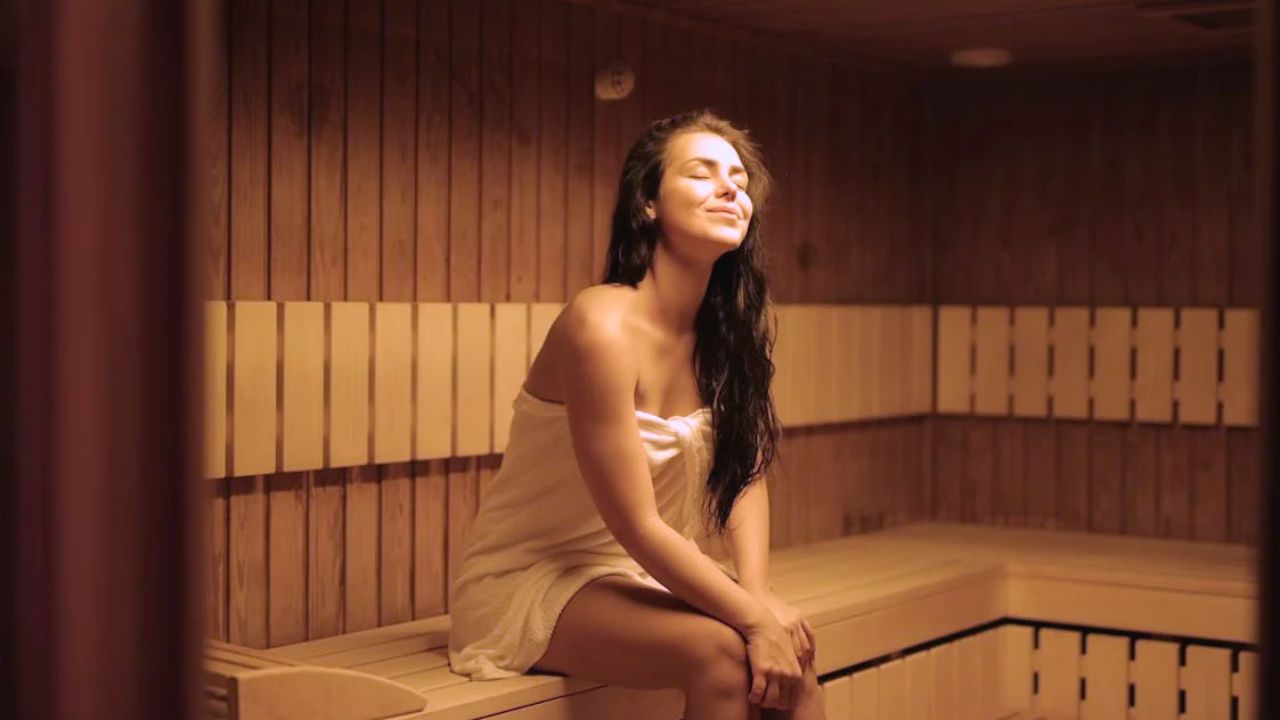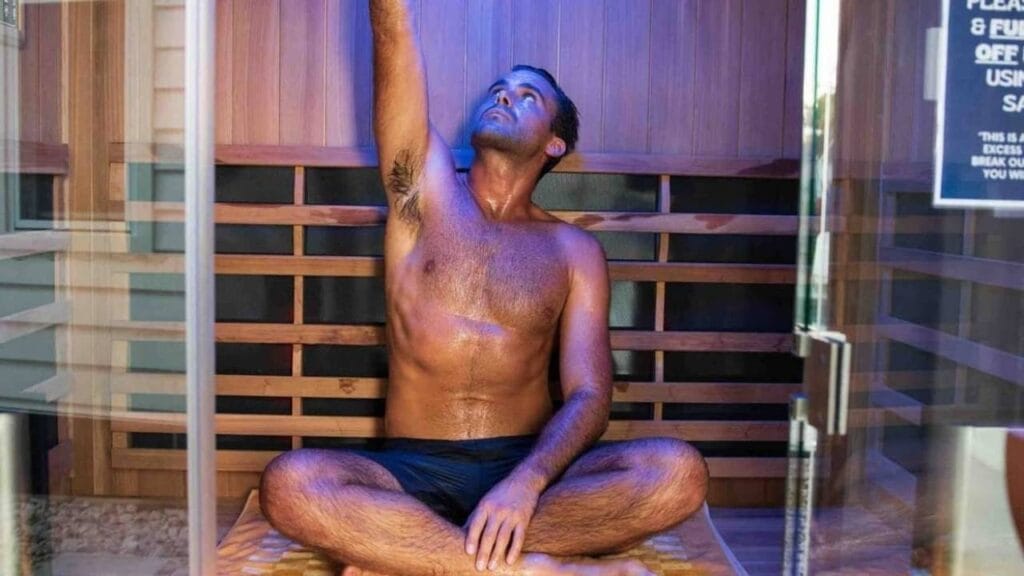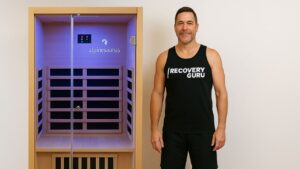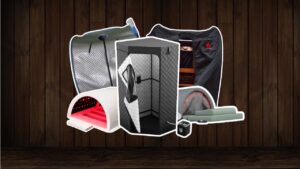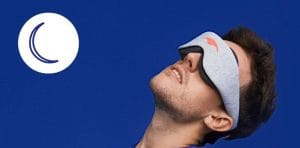This article has been medically reviewed by experts to ensure it provides accurate, reliable, and up-to-date health information. We only use credible sources to support our content.
Saunas are all about sweating it out for relaxation and health, but two big questions often come up: “How hot should a sauna be?” and “How long should I stay in?” The answers depend on the type of sauna (traditional vs infrared) and your own comfort and experience.
In this guide, we’ll break down the ideal sauna temperature (in both Celsius and Fahrenheit) for different saunas, explain how long you should sauna per session on average, and give tips backed by science to help you get the most out of your steamy sessions.
Let’s turn up the heat – but not too much – and dive in!
Quick Key Takeaways
- Dry saunas have an average temperature range of 150°F and 190°F (66–88 °C).
- Infrared saunas are effective at lower temps, around 120°F to 140°F (49–60 °C).
- Steam rooms feel hotter due to humidity but usually stay around 110°F (43 °C).
- A good sauna session lasts 10 to 20 minutes for most people.
- Beginners should start with 5–10 minutes and increase gradually.
- Infrared sessions can go a bit longer—up to 30–45 minutes.
- For best results, use a sauna 2 to 4 times a week.
- Always hydrate well before and after.
- Leave the sauna if you feel dizzy, lightheaded, or unwell.
- Listen to your body—comfort and consistency matter more than heat extremes.
Ideal Sauna Temperature by Type of Sauna
Not all saunas run at the same temperature. The “ideal” heat setting will vary if you’re using a classic Finnish sauna (dry heat), an infrared sauna, or a steam room. Sauna temperatures are typically measured in Fahrenheit (°F) but we’ll include Celsius (°C) for reference. Below, we explore each type:
Traditional Dry Sauna (Finnish Sauna)

A traditional dry sauna – the kind with heated rocks or an electric heater in a wood-lined room – is hot and low-humidity. How hot? Usually between 150°F and 190°F (65–88 °C) inside. In fact, many Finnish-style saunas are set around 170–180°F (77–82 °C) as a happy medium. According to research, most saunas are generally kept “between 150°F and 195°F (65°C to 90°C)”.
Average Range: 150–195°F (65–90 °C). This is the range you’ll see in gyms or spas. Beginners might start at the lower end (~150°F), while seasoned sauna-goers in Finland often crank it to 180°F or more. Finnish sauna enthusiasts sometimes even go briefly above 200°F (93 °C), but that’s extreme – not recommended for most people.
Ideal Sweet Spot: Around 170°F (77 °C) give or take. Many find 160–175°F to be a comfortable range balancing heat benefits and comfort. If you’re new or sensitive to heat, even 150°F (65 °C) can deliver benefits without overwhelming you.
Why So Hot? Dry saunas heat the air around you, which then heats your body. The low humidity (often 5–20%) means your sweat evaporates, cooling you a bit. That’s why 170°F in a dry sauna is tolerable – your body self-regulates by sweating. In contrast, a steam room at 170°F would be unbearable because you can’t cool off in 100% humidity (more on steam rooms soon).
Safety Note: Traditional saunas should not exceed ~212°F (100 °C) in normal use. Above that, you’re approaching boiling water temperature! Most sauna thermostats max out around 194°F (90 °C) for safety. Extremely high temps (e.g. 110°C/230°F used in competitions) are dangerous – there have been incidents of people losing consciousness or worse in “who can endure the hottest sauna” contests. So, while a seasoned sauna lover might handle 200°F for a few minutes, it’s safest to stay under ~190°F unless you’re very experienced and monitoring yourself closely.
If the sauna feels too hot on your first try, sit on a lower bench (heat rises, so it’s cooler near the floor) or simply step out for a breather. You can also ask others before adjusting the thermostat or adding water to rocks to boost humidity– sauna etiquette matters, especially in public saunas!
Infrared Sauna
Infrared saunas are a modern twist – they use infrared light emitters to heat your body directly rather than super-heating the air. This means the air temperature in an IR sauna is significantly lower, but you still sweat a lot.
Average Range: 120–140°F (49–60 °C). Infrared saunas usually operate between about 110°F and 140°F. Most models top out at ~60 °C (140°F). Often users keep them around 120–130°F (49–54 °C) for a good sweat. This might feel merely “warm” compared to a traditional sauna, but don’t worry – you’ll still sweat buckets!
Why Lower Temp Works: Infrared light penetrates your skin and raises your core body temperature from within. Essentially, your body absorbs the infrared energy, which induces sweating and an elevated heart rate similar to moderate exercise. Because of this, “an infrared sauna gives these results at lower temperatures than a regular sauna”. It’s a great option if you find 180°F unbearable or if you want a longer, milder heat session. Infrared saunas cause vigorous sweating and cardiovascular effects “at lower temperatures”, making them more tolerable for people who “can’t stand the heat of a sauna”.
Ideal Setting: 125°F (52 °C) is a common recommendation. Many infrared sauna users keep the temp around 120–130°F and stay in longer (20-30 minutes). In Sunlighten’s user story, a 69-year-old user says “I keep my sauna in the 125° to 130° range, and this is high enough to make me sweat”. You can certainly experiment within the 120–140°F range to find what feels comfortably sweat-inducing for you.
No Need to Go Higher: Pushing an infrared sauna above 140°F isn’t usually necessary or even possible on some units. Unlike traditional saunas, cranking an IR sauna to “max heat” isn’t the goal – you won’t get significantly more benefit from 150°F vs 130°F in infrared saunas, because the infrared penetration (and thus your core warming) is the limiting factor, not the ambient air temp. In fact, no harmful effects have been reported with infrared saunas in studies so far, suggesting they’re safe within that typical heat range for most people (assuming you’re healthy and hydrate properly).
Infrared saunas warm up slower than an oven but faster than a wood sauna. Give them ~10 minutes to preheat. If it’s a cold day or the sauna is outdoors, it might need a bit longer to reach, say, 120°F. Plan accordingly so your session isn’t cut short waiting for heat.
Below are some of our latest reviews on infrared saunas. You might like them!
Steam Sauna (Steam Room)

Steam rooms (often called Turkish baths or steam saunas) use steam to create a high-humidity environment. They actually run at much lower temperatures but feel very hot due to 100% humidity.
Average Range: 100–120°F (38–49 °C), at nearly 100% humidity. That might sound cool compared to other saunas, but in a steam room your skin can’t evaporate sweat to cool off, so even 110°F (43 °C) with steam can feel intense. Most steam rooms are kept around 110°F (~43 °C) for comfort, though some range from about 100 up to 120°F.
Experience: In a steam sauna, you’ll notice you can breathe the hot air only in short stints – it’s a wetter heat. The steam can help clear sinuses and is great for the skin, but you typically won’t stay as long as in a dry sauna because the heat feels more oppressive on the body (even though the thermometer reading is lower).
Ideal Duration: (We’ll cover general sauna timing below, but note that steam sessions are often shorter – ~10 minutes – since your body might overheat faster when it can’t cool via evaporation.)
Dry Sauna vs Steam: One rule some sauna enthusiasts mention is the “Rule of 200” – basically, temperature (°F) + relative humidity. In a dry sauna, humidity might be 10%, so at 180°F the “feel” is 180+10 ≈ 190. In a steam room, humidity is ~100%, so at 110°F, “feel” is 110+100 = 210 – off the charts! This is a rough way to illustrate why steam at 50°C can feel as hot as dry air at 90°C. The takeaway: lower temps suffice when humidity is high.
Note: Our focus in this article is mainly on dry vs infrared saunas, since those are most common for personal and gym use. But it’s good to know steam rooms operate differently. If you ever try one, remember that even though the thermometer says “only 45°C”, it will feel very hot. Listen to your body and don’t overdo time in steam.
Learn more: Differences Between Traditional, Steam, and Infrared Saunas
How Long Should You Stay in a Sauna?
Now that we know how hot to go, let’s talk time. Spending the right amount of time in the sauna is crucial – enough to benefit, but not so long that you risk dehydration or overheating. The answer depends on your experience level, health, and the sauna type.
Recommended Sauna Session Length
| Experience Level | Sauna Type | Recommended Duration | Notes |
|---|---|---|---|
| Beginner | Traditional or Infrared | 5–10 minutes | Start slow and exit if feeling dizzy or overheated |
| Intermediate | Traditional Sauna | 10–20 minutes | Typical session length for most users |
| Experienced | Traditional Sauna | 20–30 minutes | Only with proper hydration and cooldown breaks |
| Any Level | Infrared Sauna | 20–45 minutes | Lower heat allows for longer sessions |
| Any Level | Steam Room | 10–15 minutes | High humidity makes heat feel more intense |
For most healthy adults, a good general guideline is about 10 to 20 minutes per sauna session. If you’re new to saunas, err on the shorter side; if you’re very experienced, you might extend toward the higher end. Here’s a breakdown:
Beginners: 5–10 minutes. The first few times you sauna, don’t try to be a hero. Your body needs to adjust to intense heat. An article in the American Journal of Public Health recommended beginners start with no more than about 5–10 minutes until you know how you react. You can always do multiple short rounds (e.g. two 8-minute sessions with a cool-down in between) rather than one long bake. Pay attention to how you feel – it’s normal to feel very warm and sweaty, but you should not feel dizzy or nauseated. If you do, leave the sauna immediately.
Average Sauna Users: 15–20 minutes. This is a typical session length used in many studies and by regular sauna-goers. In fact, 15 minutes at ~170°F is a common “dose” that provides cardiovascular benefits akin to moderate exercise. One Finnish study found that men who typically stayed in the sauna about 19 minutes per session reaped more heart-health benefits than those who stayed ~11 minutes. Most sauna bathers target somewhere around the 10 to 20 minute range per round, which is enough to get a good sweat and increase circulation without overstressing the body.
Women may benefit from slightly shorter sessions, especially if breastfeeding, dealing with hormonal imbalances, or actively working out. A quick sauna for recovery can be incredibly supportive after a workout, for menstrual cramps, stress, and even sleep quality when used moderately.
Experienced/Advanced: 20–30 minutes (with caution). Some people who are very heat-adapted might do 30-minute stretches, especially in infrared saunas at lower temps. Infrared sauna sessions often last 30-45 minutes since the heat is milder. For example, one IR sauna user’s “sweet spot” was a 30 minute session at 125°F. Traditional sauna users occasionally push to ~30 minutes as well, but usually with breaks. It’s worth noting that staying beyond 30 minutes in a very hot (180°F+) sauna is generally not advised without cooling breaks. Even if you’re fit, prolonged high heat exposure can lead to dehydration or put strain on your heart.
Listen to your body: if you feel great at 20 minutes and are well-hydrated, you could extend a bit, but there’s typically diminishing returns after ~30 minutes in one go.
Maximum: Many gyms post guidelines to limit sauna time to 15 or 20 minutes. While there’s no cutoff, the risks of dehydration and overheating do rise with longer exposure. A reasonable max for one continuous session is ~30 minutes for traditional saunas (less if very hot; possibly a bit more for infrared since it’s gentler). If you want more sauna time, it’s safer to do multiple shorter sessions rather than one marathon. For instance, Finnish tradition might involve 2–3 rounds of 10-15 minutes each, rather than a single 40-minute sit.
When your body experiences this kind of heat stress, it triggers something deeper — a cellular response. Your body activates heat shock proteins (HSPs), especially HSP70 and HSP90, which help protect cells from stress and inflammation. Regular sauna use boosts HSP levels, which may support everything from better recovery to long-term cardiovascular health (Hussain & Cohen, 2018).
Cooling Down and Multiple Rounds
Instead of thinking you must get all your sauna benefit in one sitting, consider splitting your sauna time into rounds with cool-down periods:
Many sauna veterans do something like 2 or 3 rounds of 10–15 minutes. Between rounds, they’ll cool off – perhaps stepping out to drink water, take a quick cool shower, or just sit at room temp for a few minutes. In Finland, it’s common to jump into a cold plunge or even roll in the snow between sauna sessions (the extreme version of cooling down!). You don’t have to go that far, but a cool rinse or simply resting outside the sauna for 5 minutes helps lower your core temperature a bit before you go back for another round.
Why multiple rounds? It allows you to get a cumulative effect (lots of sweating, relaxation, and the fun of reheating and cooling) without overstressing your body continuously. Think of it like interval training for heat exposure. For example, you might do:
15 minutes heat → 5 minutes cooling off → 15 minutes heat again.
This could achieve more total sauna time (30 min total) but with less risk than a straight 30.
Sun Valley Saunas mentions “three 20 minute sauna sessions with 3 minute breaks in between” as their routine– that’s an advanced routine, but it illustrates the concept.
If you’re in an infrared sauna, cool-down breaks might not be necessary since the heat stress is lower; many IR users just do one longer continuous session and then end.
How Often Can You Sauna?
| Frequency | Best For | Health Benefit Notes |
|---|---|---|
| 1–2 times per week | Beginners or casual users | Good for relaxation and light cardiovascular benefit |
| 3–4 times per week | General wellness routine | Supports cardiovascular health, better sleep, and recovery |
| 5–6 times per week | Advanced sauna users | May offer additional benefits but requires hydration and rest |
| 7 times per week | Highly experienced, healthy individuals | Only recommended if you’re recovering well and staying hydrated |
Besides session length, people often ask how frequently to use the sauna (weekly). Research suggests regular sauna use has the best health outcomes. In a 20-year study of Finnish men, those who used a sauna 4–7 times per week had significant reductions in cardiovascular issues and mortality compared to once-a-week users. This doesn’t mean you must sauna every day to benefit, but consistency helps.
General recommendation: 2–3 times per week is great for maintenance and health benefits, and up to 4+ times a week for potentially greater cardiovascular benefit. Even once a week is relaxing, but the positive effects (like improved circulation, blood pressure, stress reduction) tend to be dose-dependent: more sessions (within reason) yield more benefit.
However, daily saunas are not necessary for most people – and you should always stay attuned to your body. Sauna bathing is somewhat taxing (like exercise). Your body needs to rehydrate and recover, so taking at least a day or two off each week is wise if you sauna very frequently.
For healthy adults, 3-4 sauna sessions per week (each around 15-20 minutes at ~80-90 °C) appears to be a optimal spot for health and wellness benefits. But even 1–2 sessions weekly can be beneficial for relaxation and minor cardiovascular perks. Always prioritize hydration and rest on days you sauna.
Safety Tips and Best Practices When Using Saunas of All Types
Saunas are generally safe when used correctly, but high heat can be risky if you ignore your body’s signals or have certain health conditions. Keep these safety tips in mind to ensure your sauna time is beneficial and not harmful:
Stay Hydrated: You sweat a lot in a sauna – which is great – but that means you’re losing water and electrolytes. Drink at least one full glass of water before and after your sauna session. If you plan to do multiple rounds or a long session, have water accessible to sip during breaks. Never drink alcohol in the sauna or use it to “sweat out” a hangover – that’s a recipe for dehydration or heat stroke. Stick to water or sports drinks (and alcohol is best avoided before/after sauna as well).
Don’t Overstay Your Welcome: As discussed, 15-20 minutes at a time is usually enough. Pushing far beyond your comfort can lead to dizziness or fainting. An authoritative source recommends “healthy people not sit in a sauna for more than 10 to 15 minutes at a time”. You can always cool down and go back in if you want more. Never fall asleep in a sauna! It sounds obvious, but the relaxing heat can occasionally make people nod off – set a timer or stay alert. Falling asleep could mean you overheat without realizing it.
Cool Down Properly: If you’ve had a good sweat, give your body time to cool gradually. Sudden temperature changes (like jumping straight from a super-hot sauna into an ice-cold pool) are a tradition for some, but can stress your heart. It’s invigorating but not recommended for everyone, especially if you have blood pressure or heart issues. It might be better to let your body return to normal temperature slowly– sit and relax, or take a lukewarm shower, before going very cold. If you do try contrast therapy (hot-to-cold), be cautious and aware of how you feel.
Know Your Health Status: Saunas aren’t for everyone. If you have uncontrolled high blood pressure, a heart condition, arrhythmia, or diabetes, check with your doctor before using a sauna. Same goes if you’ve recently had a heart attack or have unstable angina. Often, doctors will still allow sauna use with precautions (saunas can actually improve cardiovascular health in stable patients), but it’s important to get the green light. If you’re on medications that affect heart rate, blood pressure, or make you sweat less/more, ask a doctor – some drugs (and even some recreational substances) can impair your body’s cooling mechanisms.
Pregnancy: Pregnant women need to be very careful with overheating. While some guidance suggests short sauna sessions might be okay, the NHS warns that becoming overheated in a sauna can be dangerous during pregnancy. High maternal body temperature, especially in the first trimester, has been linked to certain fetal development issues. Many doctors advise pregnant patients to avoid saunas and hot tubs altogether to be safe. If you’re determined to use a sauna while pregnant, absolutely discuss with your healthcare provider and keep sessions extremely brief (5-10 minutes max at lower heat).
Listen to Your Body: This cannot be overstated. Everyone’s heat tolerance is different. Factors like how well-hydrated you are, whether you just exercised, or even if you got enough sleep can affect your sauna tolerance on a given day. If you start feeling lightheaded, nauseous, extremely tired, or get a headache, exit the sauna promptly. Cool down, drink water, and rest. There’s no benefit in “toughing it out” through discomfort – you won’t magically double the health perks by staying an extra 5 minutes, but you could harm yourself. The goal is relaxation and health, not a torture endurance test!
Never Use a Sauna Under the Influence: This is a safety must. Do not use the sauna if you’re drunk or on recreational drugs that could dull your senses. You might not realize you’re overheating. Even certain prescription drugs (like sedatives) could be risky – if a medication makes you drowsy or affects sweating, skip the sauna that day.
Cool Shower Afterward: It’s a good idea to rinse off after a sauna (once you’ve cooled down a bit). This helps wash away sweat and can close up your pores. It also simply leaves you feeling refreshed. In Finnish routines, people often shower or jump in a lake after the final round– you can emulate this with a nice cool shower. Just make sure you’ve cooled down enough that the shower isn’t a shock.
Following these safety tips will ensure your sauna experience is enjoyable and reduces any risks. Sauna bathing, when done responsibly, is very safe – studies even show it’s well-tolerated by those with stable health conditions under supervision. Use common sense and it can be a wonderful, healthy habit.
Frequently Asked Questions
A typical dry sauna (Finnish sauna) should be between 150°F and 190°F (66–88 °C). The ideal temperature depends on your comfort – many people aim for ~170–180°F. If you’re newer to saunas, you might start at the lower end (~150°F) and gradually work up.
Most public saunas keep the thermostat around 180°F (82 °C). You’ll usually find it in the 170–190°F range. Steam rooms are cooler, often ~110°F (43°C) due to the humidity.
For most people, 15 to 20 minutes per session is enough for benefits. Advanced users might stay longer with breaks, but it’s better to do regular, moderate sessions than overdo it.
If you’re healthy and stay hydrated, 3–4 times a week is a good target. Some studies suggest benefits with daily use, but recovery days are helpful too.
No. Infrared saunas work at lower temperatures (typically 120–140°F) because they heat the body directly. You’ll sweat just as much, and possibly stay in longer.
If you feel dizzy, nauseous, or uncomfortable, it’s too hot. You should be sweating and warm, not faint. Listen to your body – it’s better to leave early than push through discomfort.
References
Bauer, B. A. (2018). What is an infrared sauna? Does it have health benefits? Mayo Clinic. Retrieved from https://www.mayoclinic.org/healthy-lifestyle/consumer-health/expert-answers/infrared-sauna/FAQ-20057954
Gong, J., Munoz, A. R., & Chan, D. C. (2019). Heat shock proteins create a signature to predict the clinical outcome in breast cancer. Scientific Reports, 9, 6290. https://doi.org/10.1038/s41598-019-43556-1
Henle, K. J., & Dethlefsen, L. A. (1995). Heat shock proteins, thermotolerance, and their relevance to clinical hyperthermia. International Journal of Hyperthermia, 11(3), 459–488. https://doi.org/10.3109/02656739509022483
Hussain, J., & Cohen, M. (2018). Clinical effects of regular dry sauna bathing: A systematic review. Evidence-Based Complementary and Alternative Medicine, 2018, Article ID 1857413. https://doi.org/10.1155/2018/1857413
Laukkanen, T., Khan, H., Zaccardi, F., & Laukkanen, J. A. (2015). Association between sauna bathing and fatal cardiovascular and all-cause mortality events. JAMA Internal Medicine, 175(4), 542–548. https://doi.org/10.1001/jamainternmed.2014.8187
Laukkanen, T., Kunutsor, S. K., Kauhanen, J., & Laukkanen, J. A. (2017). Sauna bathing is inversely associated with dementia and Alzheimer’s disease in middle-aged Finnish men. Age and Ageing, 46(2), 245–249. https://doi.org/10.1093/ageing/afw212
National Health Service (NHS). (2017). Saunas and pregnancy – precautions. (Referenced in text: caution against overheating during pregnancy).
North American Sauna Society. (n.d.). Sauna guidelines and safety tips. Retrieved from https://saunasociety.org
Zhao, Q., Liu, C., & Wang, Y. (2023). An update on the status of HSP90 inhibitors in cancer clinical trials. Critical Reviews in Oncology/Hematology, 186, 103902. https://doi.org/10.1016/j.critrevonc.2023.103902

